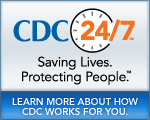MMWR
Morbidity and Mortality Weekly Report
MMWR News Synopsis for January 31, 2008
- (Box) American Heart Month — February 2008
- Receipt of Outpatient Cardiac Rehabilitation Among Heart Attack Survivors — United States, 2005
- Multijurisdictional Workplace-Based Investigation of Contacts of a Highly Infectious Tuberculosis Patient —Maryland, District of Columbia, and Virginia, 2006
There will be no MMWR telebriefing scheduled for:
January 31, 2008
(Box) American Heart Month — February 2008
PRESS CONTACT: CDC
Division of Media Relations
(404) 639–3286
No Summary Available
Receipt of Outpatient Cardiac Rehabilitation Among Heart Attack Survivors — United States, 2005
PRESS CONTACT: Rosa Norman, CDC Press Officer
Division for Heart Disease and Stroke Prevention
National Center for Chronic Disease and Health Promotion
(770) 488–8214
Cardiac rehabilitation is critical for survivors of heart attack to decrease their chances of death and disability and should be incorporated in outpatient treatment plans for eligible patients. Only about one in three heart attack survivors are participating in services that have been shown to reduce death and disability related to heart disease, according to a new CDC study. The study analyzed 2005 Behavioral Risk Factor Surveillance System data collected from 21 states and the District of Columbia. Researchers found that only 34.7 percent of heart attack survivors took advantage of outpatient cardiac rehabilitation services, which include medically supervised exercise, nutritional and psychosocial counseling; weight, cholesterol level, blood pressure, and diabetes management; and smoking cessation. The percentage of heart attack survivors receiving outpatient cardiac rehabilitation ranged from 22.6 percent in DC to 59.1 percent in Nebraska. The study also found disparities among persons who receive cardiac rehabilitation exist by age, race/ethnicity, sex, income, geography, and level of education.
Multistate Outbreak of Salmonella Infections in Humans Associated with Exposure to Turtles —United States, 2007
PRESS CONTACT: Doug McBride, Press Officer
Texas Department of State Health Services
(512) 458–7524
The investigation of contacts of persons with TB disease, or the conduct of a contact investigation is one of the main methods of preventing future TB cases. Contact investigations involve identifying and treating persons with latent TB infection. In an era of limited public health resources, it is important to prioritize screening of contacts of an infectious TB patient. Workplace-based TB contact investigations have become an important strategy, as highlighted by the 2005 CDC contact investigation guidelines, especially during investigations where patients may have difficulty recalling and naming contacts. Today, where individuals are increasingly mobile, due to travel for work for example, prompt cooperation and collaboration between affected jurisdictions is essential. Finally, prompt diagnosis of TB disease is important in prevention of future cases. Individuals with symptoms of cough, fever, weight loss, night sweats, bloody sputum, and/or malaise should consult their health care provider. In response to the diagnosis of pulmonary tuberculosis in a Maryland resident, the Maryland Department of Health and Mental Hygiene, together with other state and local health departments in the national capital region, conducted a contact investigation in the spring of 2006. The TB patient was a 46-year old man who traveled over a widespread area in Maryland, the District of Columbia, and Virginia as part of his job for an office furniture installation company. Because of close contact with co-workers while performing work duties, the patienta€?s workplace formed the focus of this contact investigation. The purpose of the contact investigation was to determine the extent of TB transmission, including identifying and screening any exposed contacts and to provide treatment to contacts with TB infection or TB disease.
####
- Historical Document: January 31, 2008
- Content source: Office of Enterprise Communication
- Notice: Links to non-governmental sites do not necessarily represent the views of the CDC.
View Press Releases in
Get e-mail updates
To receive e-mail updates about this page, enter your
e-mail address:
Contact Us:
- Centers for Disease Control and Prevention
1600 Clifton Rd
Atlanta, GA 30333 - 800-CDC-INFO
(800-232-4636)
TTY: (888) 232-6348 - Contact CDC-INFO


